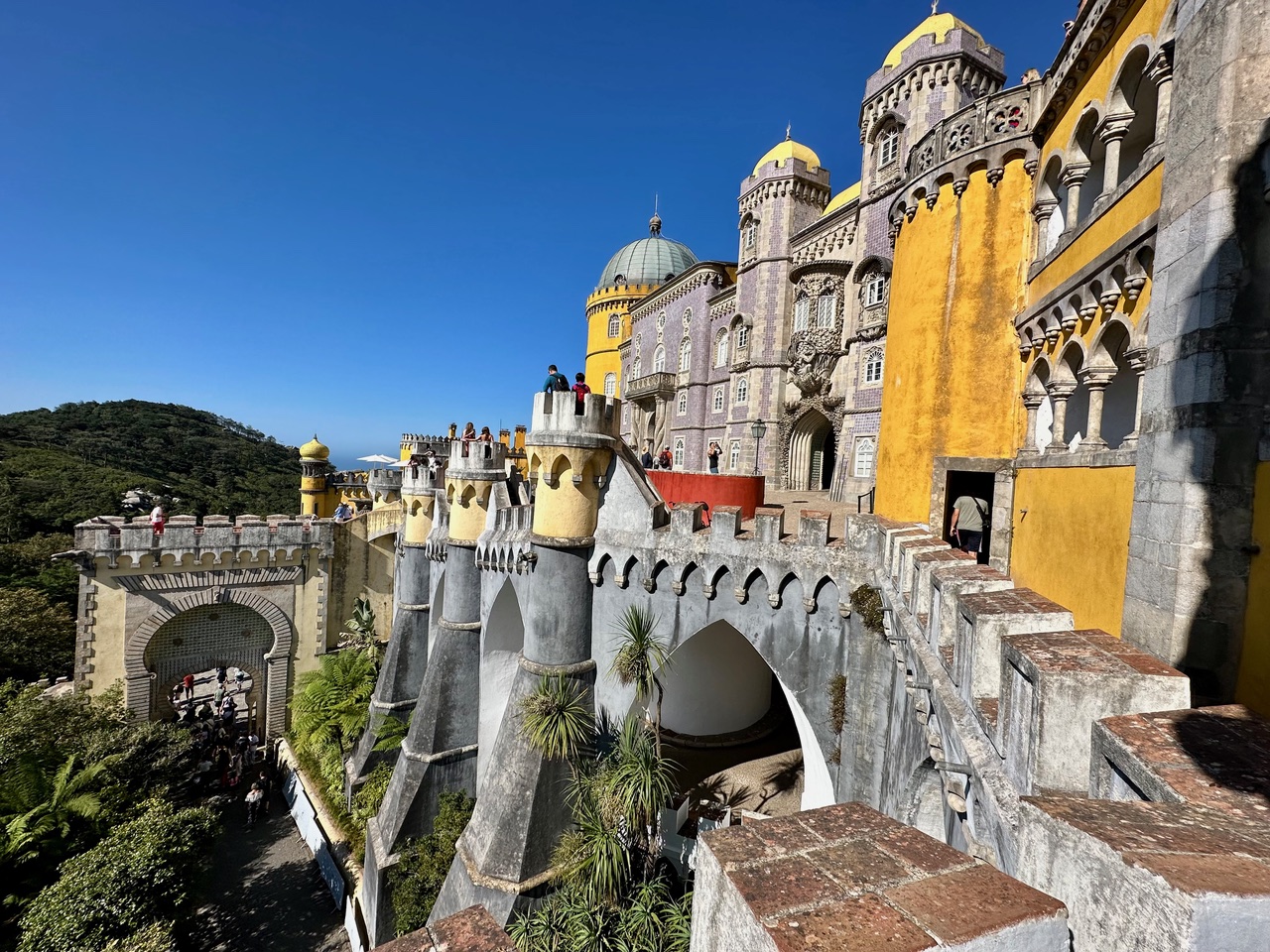5 BEST TOWNS TO EXPLORE ON YOUR TRIP TO LISBON
LOOKING FOR THE BEST TOWNS NEAR LISBON TO EXPLORE WHEN YOU ARE TRAVELING TO PORTUGAL?
The wonderful things to see and do in Lisbon make it my favorite place to spend time in Portugal. The ease of traveling to interesting small towns adds to the benefit of choosing it as a hub.
Here is my list of the best towns near Lisbon, offering stunning architecture, intriguing cultural attractions, serene natural areas, and excellent dining and shopping options. Visitors can easily reach these towns by public transportation, and they are well worth exploring.
When traveling to these towns, I have found that most people speak English and are friendly. Knowing a few pleasantries goes a long way, such as “bom dia” (good day, pronounced bone dee’uh) and “obrigado” (thank you, pronounced oh bri ga’ doo).
Sintra – Town of Castles
Sintra offers a few magical sights that transport you back in time to a fairy-tale atmosphere. If you plan a day trip from Lisbon, arrive early so you can visit two to four of the following options. Spending a night in town offers a chance for a more leisurely and thorough experience.
Pena Palace
Built in the 19th century, the Palácio Nacional da Pena, epitomizes the Romantic style characterized by its multiple turrets, pointed arches, vivid colors, and intricate details. Inside the palace, the elaborate tile and plasterwork patterns are almost overwhelming.
As the palace tends to be the most popular site in Sintra, buy tickets in advance for the first available entrance times of the morning or book a guided tour.
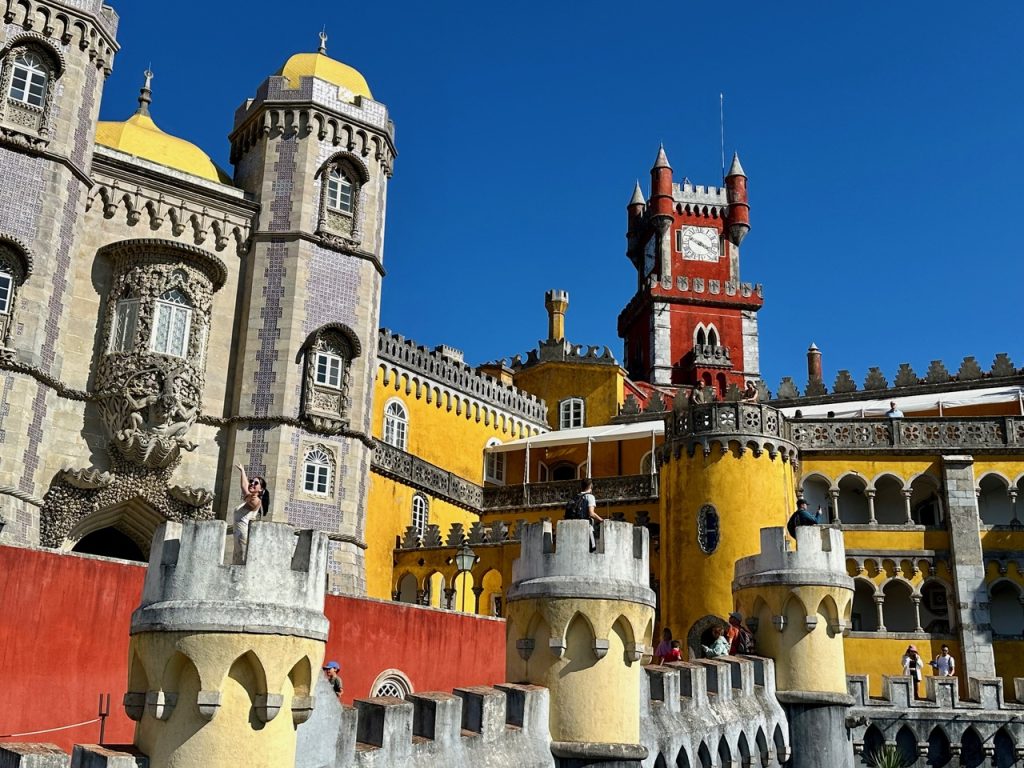
Moorish Castle
Starting in the 8th century, the Castelo dos Mouros defended the region from its craggy heights. Christian crusaders defeated the castle in 1147 and left it to ruin.
The steps along the wall of the ruins may look daunting but they are worth braving for the incredible views across the landscape. You can walk to the site from the Pena Palace in about 15 minutes through the park.
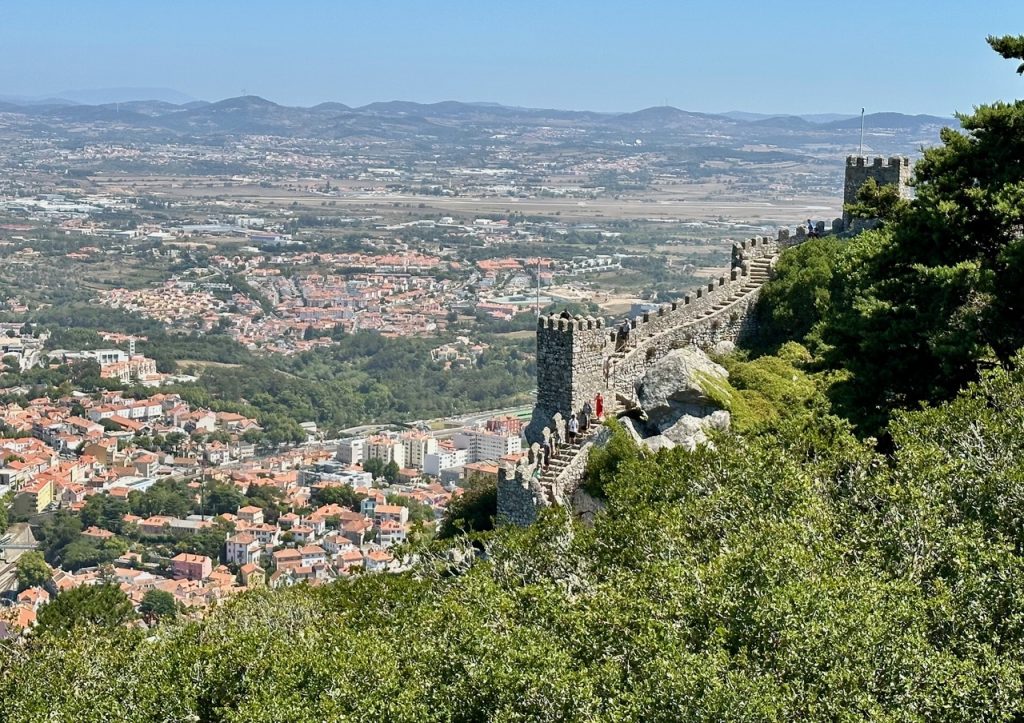
Monserrate Palace and Park
A little further out from the center of Sintra, Monserrate provides a much less crowded and more tranquil natural garden. Francis Cook, a 19th-century British industrialist, went wild with the Romantic and Islamic styles of architecture in designing the small palace in the center of the park. Lacy, elaborate designs fill the walls, ceilings, and stairways with a dreamlike elegance.
Monserrate Park consists of multiple lush gardens that made me feel like I was entering a new set of a fairy tale movie in each area. I entered on a trail past a waterfall with mossy stones, climbed up to a romantic ruin, and then crossed a broad lawn to a lily pond reminiscent of an English garden.
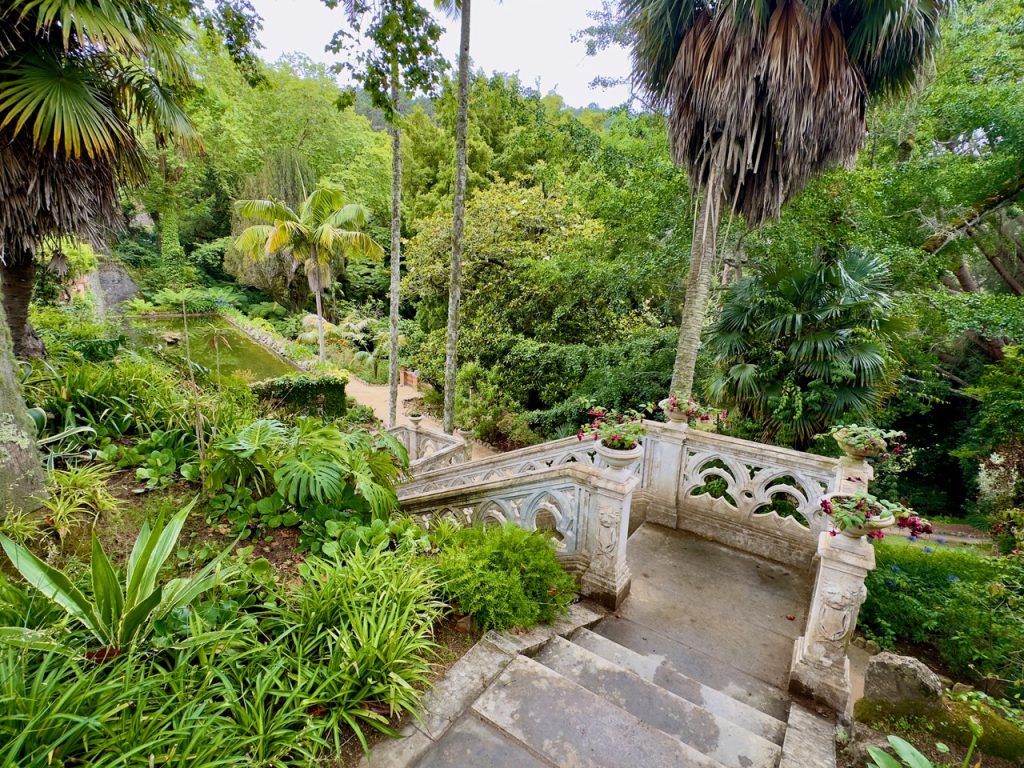
Quinta da Regaleira
The Quinta da Regaleira takes the notion of secret gardens and turns it up a couple of notches. With every turn, a fascinating feature pulls you in, including underground caverns, secret passageways, and decorative structures and fountains.
The park is within walking distance from the center of Sintra and can become crowded, but it is worth experiencing.
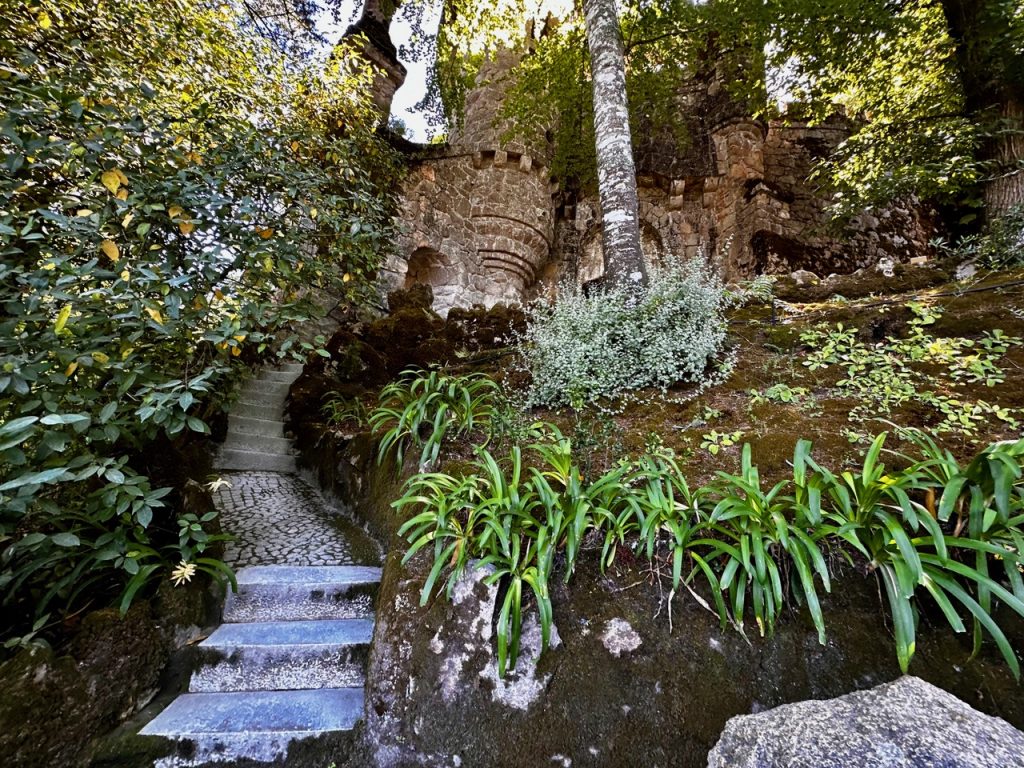
National Palace of Sintra
The construction of the National Palace of Sintra is likely to have begun in the 10th century. Kings and queens visited and renovated the building through the centuries in various styles. They used the palace when hunting in the area or trying to escape the city.
On the day my daughter and I visited the low number of tourists allowed for a leisurely stroll, providing a unique view of how the Portuguese royalty lived. The terraces also offered scenic views of the colorful town of Sintra set among vibrant foliage.
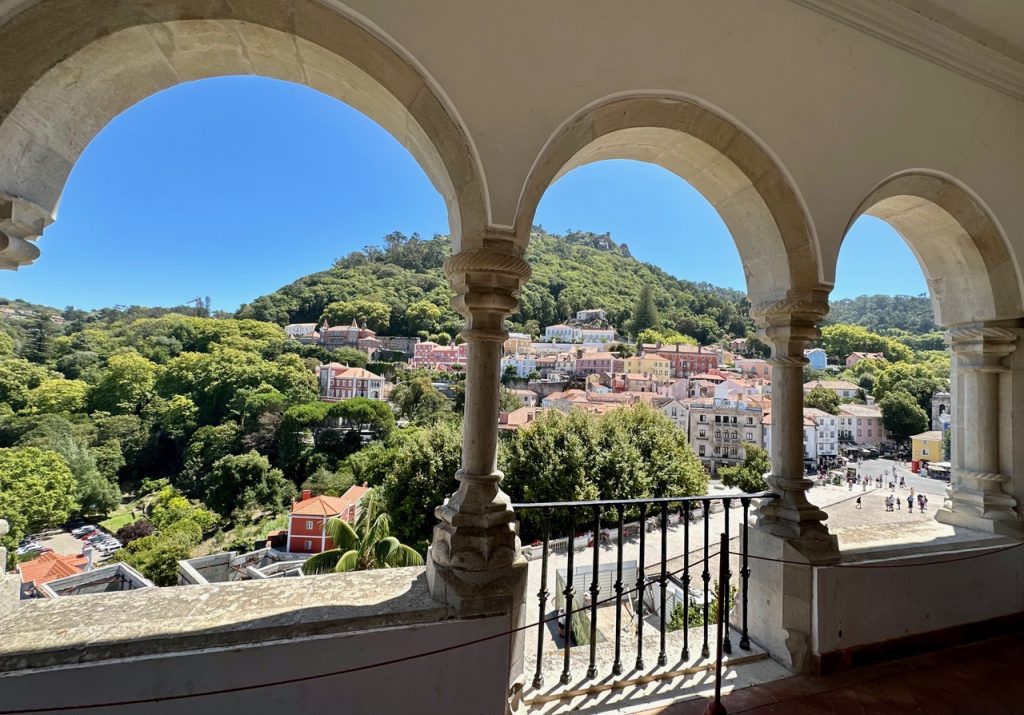
How To Get There
Commuter trains run to Sintra every 15 to 30 minutes from Rossio Station, in the center of Lisbon, or Oriente Station, on the east side of the city. There are other stations along the way to climb aboard. This train brings you to the center of Sintra and sits next to a bus stop that serves tourists visiting the sights. The train ride lasts about 40 minutes.
Buy a metro card at the station with at least two tickets on it, each costing 2.45 euros. Every person must have their own card. You will need to validate the ticket at the end of the ride as well as when entering the station.
Tour salespeople and tuk-tuk drivers wait just outside the station to entice you to their offerings. Turn to the right to find a line of people waiting to board the 434 bus, which costs 13.50 euros for a day ticket and winds along the one-way road to the Pena Palace, Moorish Castle, and Monserrate.
If you enjoy walking and can afford to spend a little more, skip the bus and hire a tuk-tuk or use the Bolt app to call a car to reach Pena Palace. You can then walk down the hill back into town or hire another ride. If you are traveling with others, you won’t spend much more than a bus ticket for each of you.
On my first trip, I followed the guidebooks and stood in line with my daughter for 15 minutes to catch the bus to Pena Palace. We then walked to the Moorish Castle and enjoyed the breeze in a tuk-tuk down to lunch in town. On my recent trip, I walked into town to have breakfast, then used Bolt to get a car ride up to Monserrate Park. After four hours of exploring the grounds, I called another car to get back to the train station.
Cascais – Seaside Jaunt
Less than an hour’s train or car ride from Lisbon, Cascais makes a perfect day trip or even a base from which to explore the larger city. This seaside town offers access to beaches, winding tiled sidewalks to wander, and restaurants with lovely views of the water.
This former retreat of the Portuguese royal family remains very popular today. If you can visit outside of the high season, from July to August, you will experience less crowds and a more relaxed atmosphere.
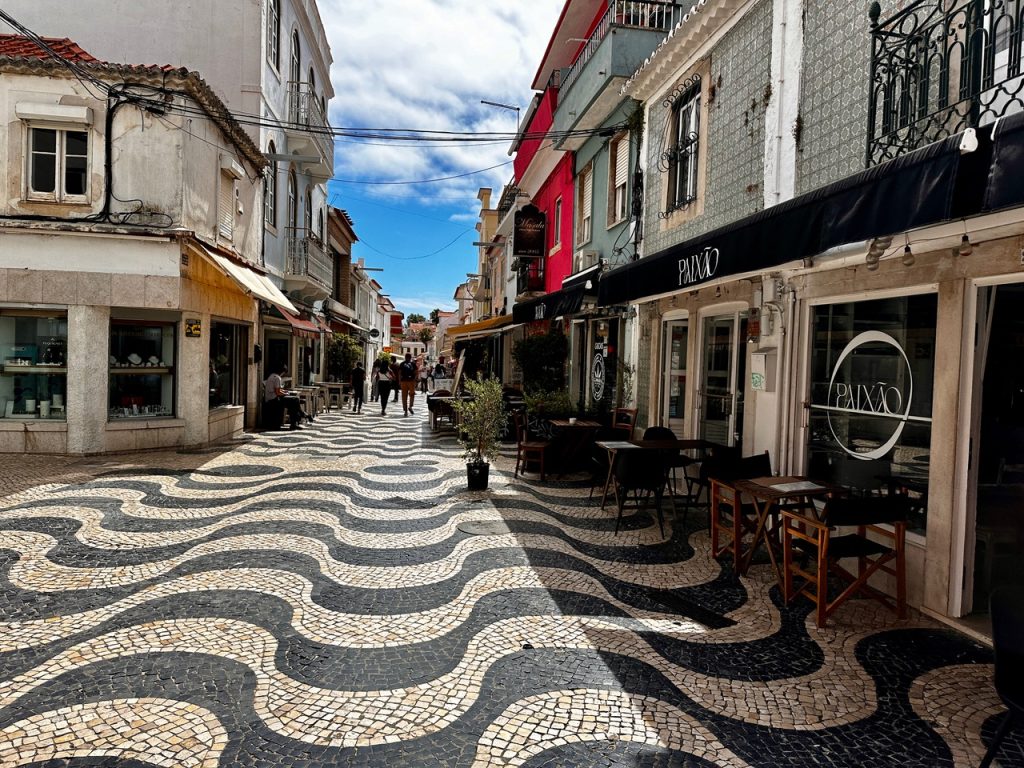
Praia da Conceicao
A three-minute walk from the Cascais train station brings to you Praia da Conceicao. This lovely stretch of sand provides the perfect spot to enjoy the frequent sunny days of Portugal. The water is calm, and many places offer a great view while grabbing a meal or drink. You can also rent lounge chairs and umbrellas on the beach.
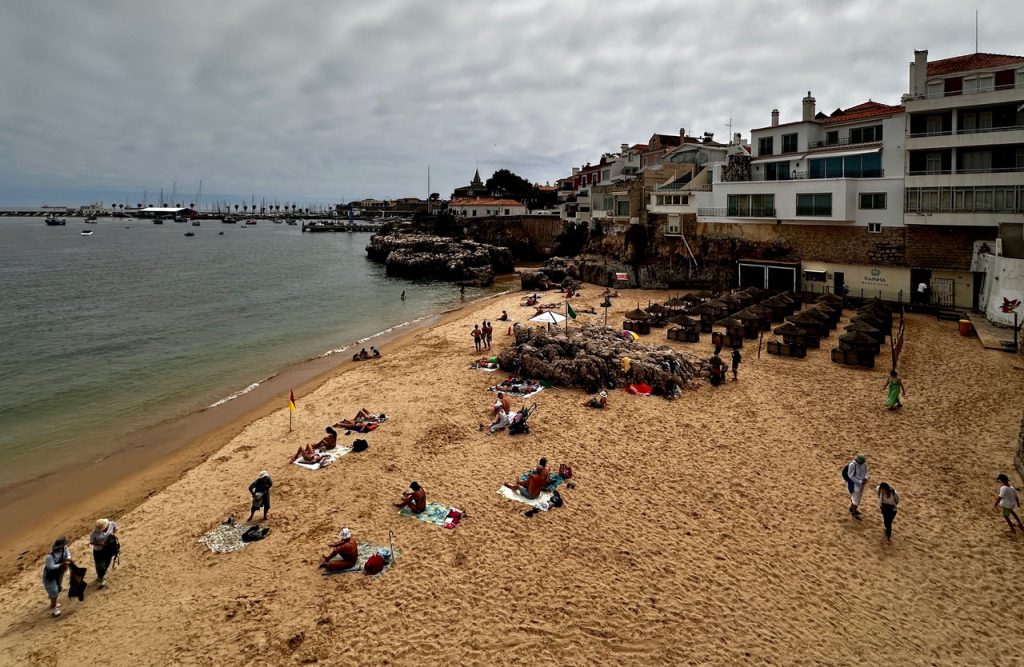
Cascais-Estoril Promenade
For a scenic walk along the river, head to the promenade that joins Cascais to Sao Joao do Estoril to the East. You can jump on the train back to Lisbon from Estoril. While walking along the boardwalk, I picked up an incredible falafel wrap at the Citron Presse food truck.
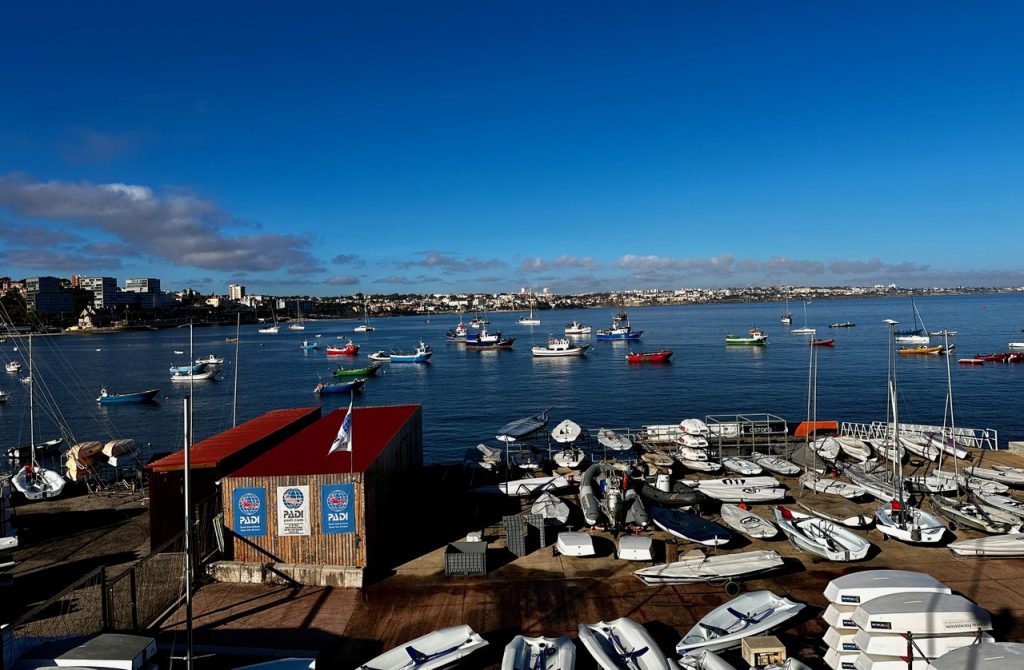
Santa Maria House
I enjoy visiting historic houses to gain a deeper understanding of the local history. The Santa Maria House, built overlooking the water in 1902, has served as the summer residence of a few Portuguese families over the years. Colorfully patterned tile and baroque blue and white tiled landscapes don the walls beneath elaborately painted ceilings.
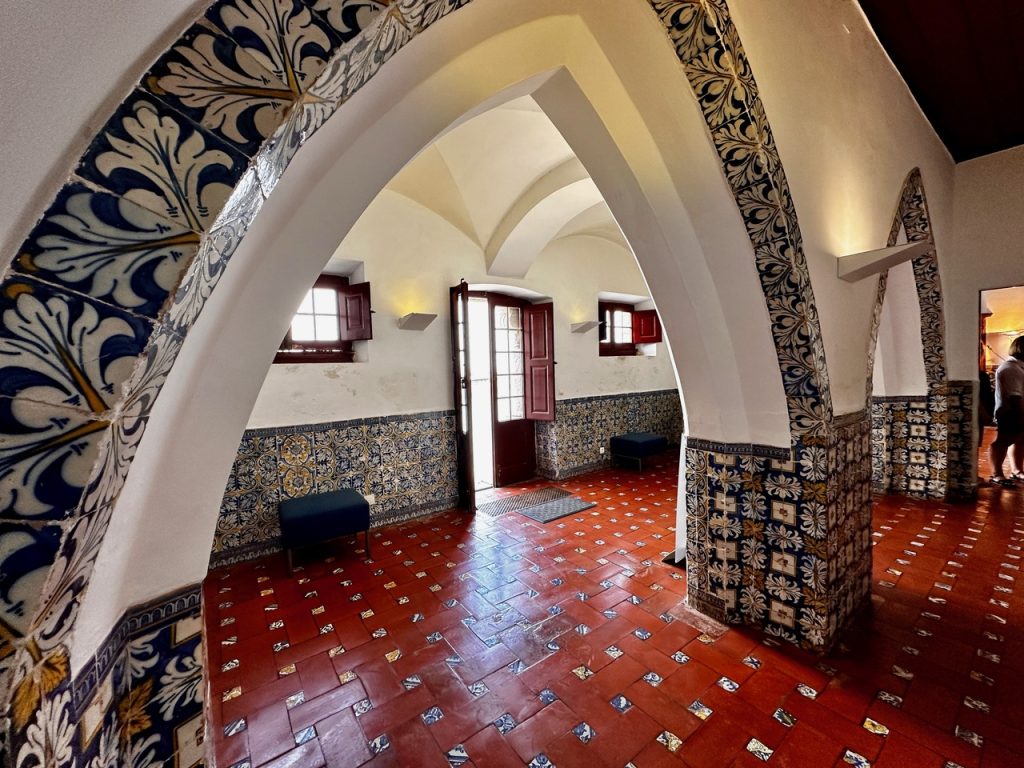
Marechal Carmona Park
For a peaceful retreat from the crowds in Cascais, wander into the Marechal Carmona Park. The lush garden offers plenty of shade, along with beautiful flowers, water features, and peacocks.
How To Get There
You can board the Linha de Cascais railway at the Cais do Sodre station which is an easy walk or tram ride from the center of Lisbon. The Cascais train station sits in the middle of town, making it easy to reach the beach or stroll through the town.
Similarly to my advice for Sintra, buy a metro card at the station with at least two tickets on it, costing 2.45 euros each. Every person must have their own card. You will need to validate the ticket at the end of the ride as well as when entering the station.
Obidos – Walled Wonder
To enter the compact town of Obidos, you pass through a double-walled gate which includes a short passageway with a tiled balcony. The narrow, cobblestoned streets still evoke the medieval center that the Queens of Portugal once owned. The white walls of the buildings feature borders of royal blue or mustard yellow, and bright fuchsia bougainvillea cascades from the terra-cotta roofs.
Walk The Walls
Climb up steep stone steps near the entrance of the town to obtain a view of the two streets branching forward and the aqueduct outside the walls. Don’t get distracted by the scenery too much, as the way is a little precarious.
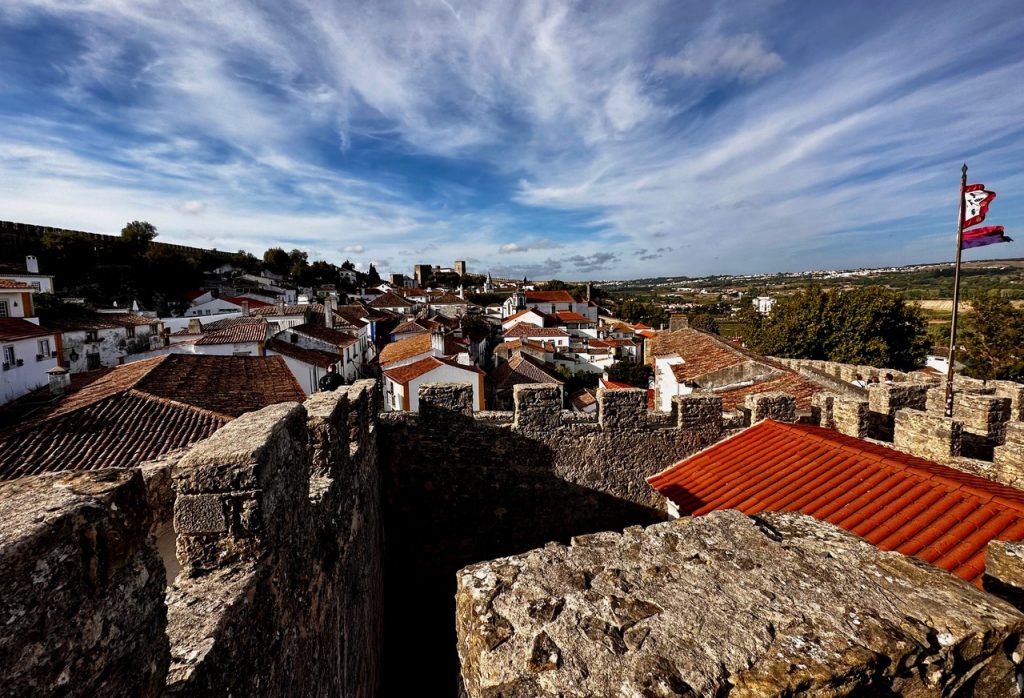
Shop and Dine
The main attraction of Obidos is its scenic, winding streets lined with many small shops and restaurants along the way. These offer fantastic traditional Portuguese souvenirs, such as ceramics and tiles.
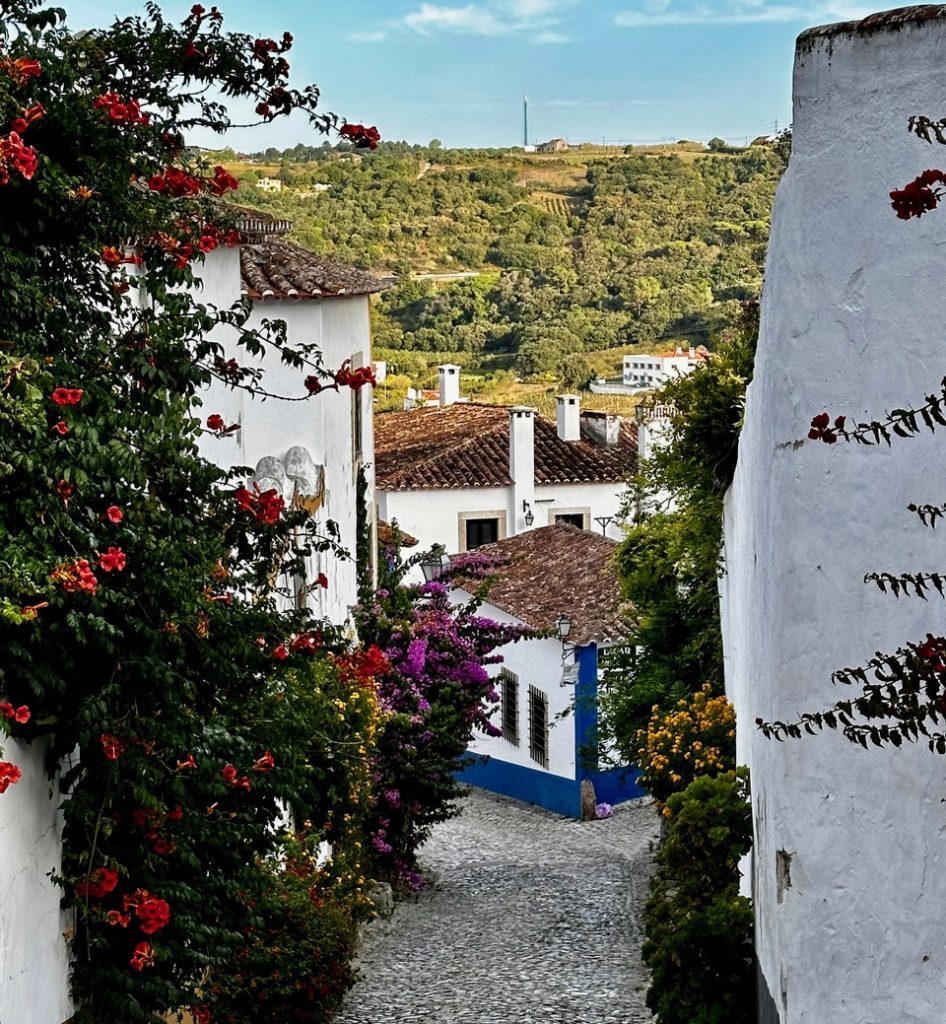
Official UNESCO Literary City
The conversion of a few buildings in Obidos, including the former Church of Santiago, into enormous bookstores sparked the town’s rejuvenation starting in 2013. Browse these shops along Rua Deireta or stay at The Literary Man, the largest book hotel in the world. The town also holds two literary festivals, one in October and one in the spring.
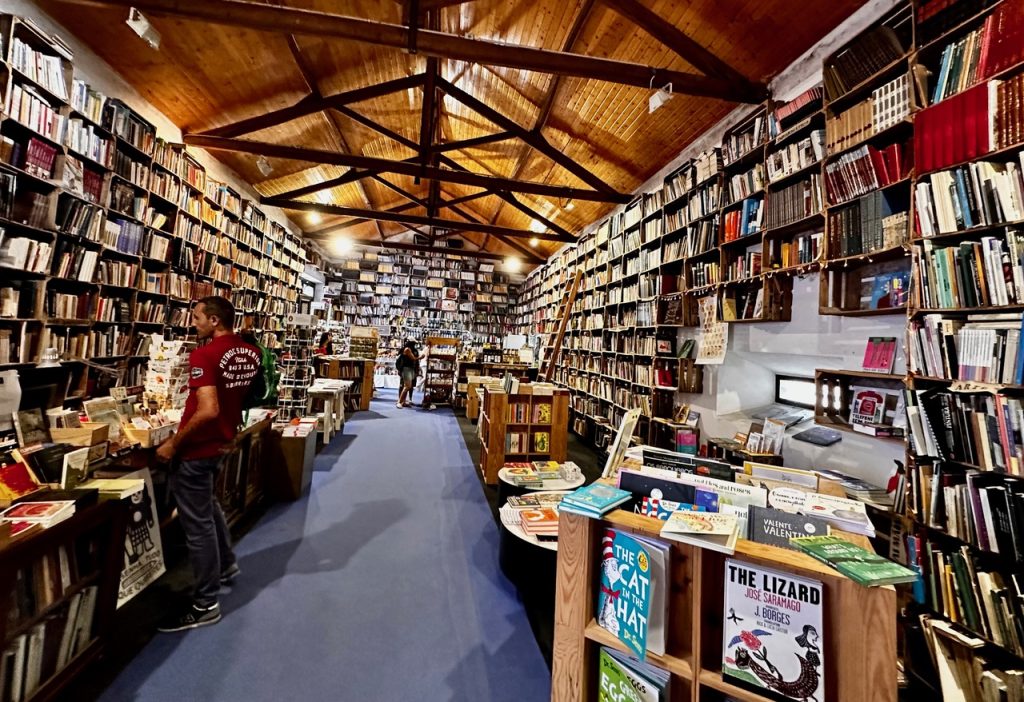
Taste Ginja
If you haven’t tasted ginja by the time you reach Obidos, this is the perfect place to give it a try. The cherry-infused liquor goes down smoothly and is especially tempting when served in a shot glass made of dark chocolate.
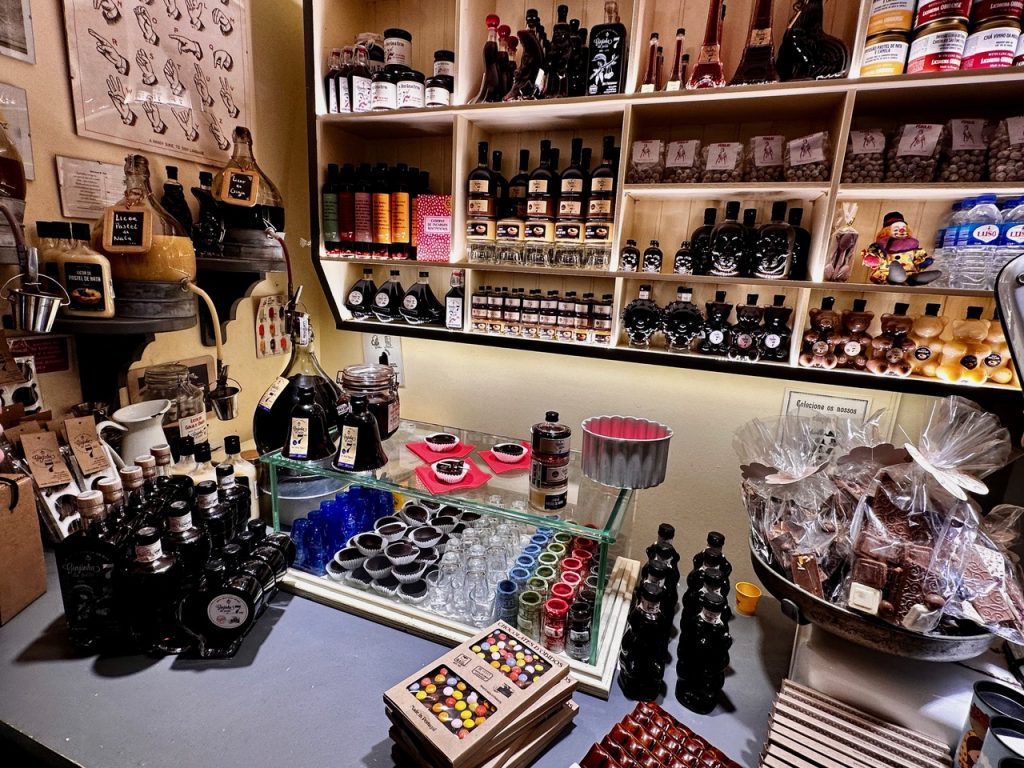
Saint Mary’s Church and Square
Initially built in the 12th century, Saint Mary’s Church underwent extensive renovation in the 16th century. Well-preserved, ornate blue-and-white tiles fill the interior walls.
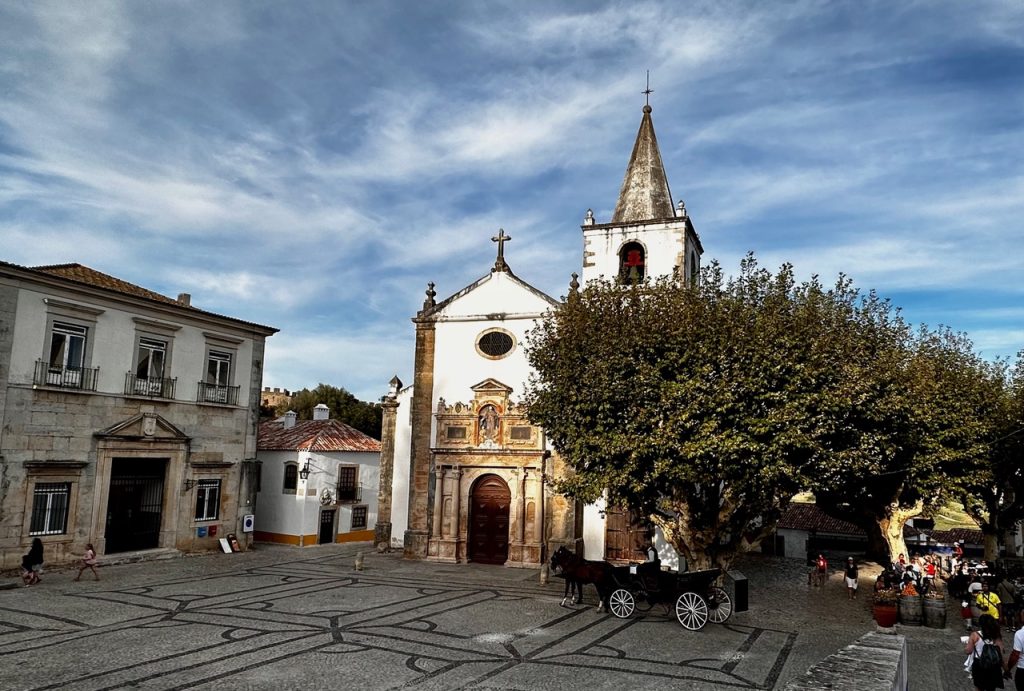
How To Get There
A bus ride to Obidos takes about an hour and leaves from Campo Grande near the Lisbon airport. The train trip lasts over two hours and departs from Santa Apolonia Station.
Obidos is one place that renting a car and driving is worth the cost and effort. This enables you to stop along the way at Balcahoa Buddha Eden, an amazing garden featuring hundreds of Buddhist, African, and wildlife sculptures, which is one of my favorite places in Portugal.
Coimbra – University Town
The town of Coimbra combines medieval charm with university vitality creating a unique and enjoyable atmosphere. Fascinating historical sights and entertaining nightlife make it worth spending at least a couple of days here.
University of Coimbra
King Dinis founded Portugal’s first university in 1290 in Lisbon, making it one of the oldest schools in the world. After alternating between Lisbon and Coimbra, the university settled permanently along the Mondego River in 1537.
Interesting sights abound throughout the grounds of the University of Coimbra, starting with the Great Hall of Acts and Private Exam Room in the former palace of the medieval kings. The main plaza offers an incredible view of the town and river, as well as an opportunity to watch students in their traditional black cloaks going about their daily activities. Just off the square sit the Joanina Library and the Chapel of Saint Michael, whose ornate interiors are a must-see. .
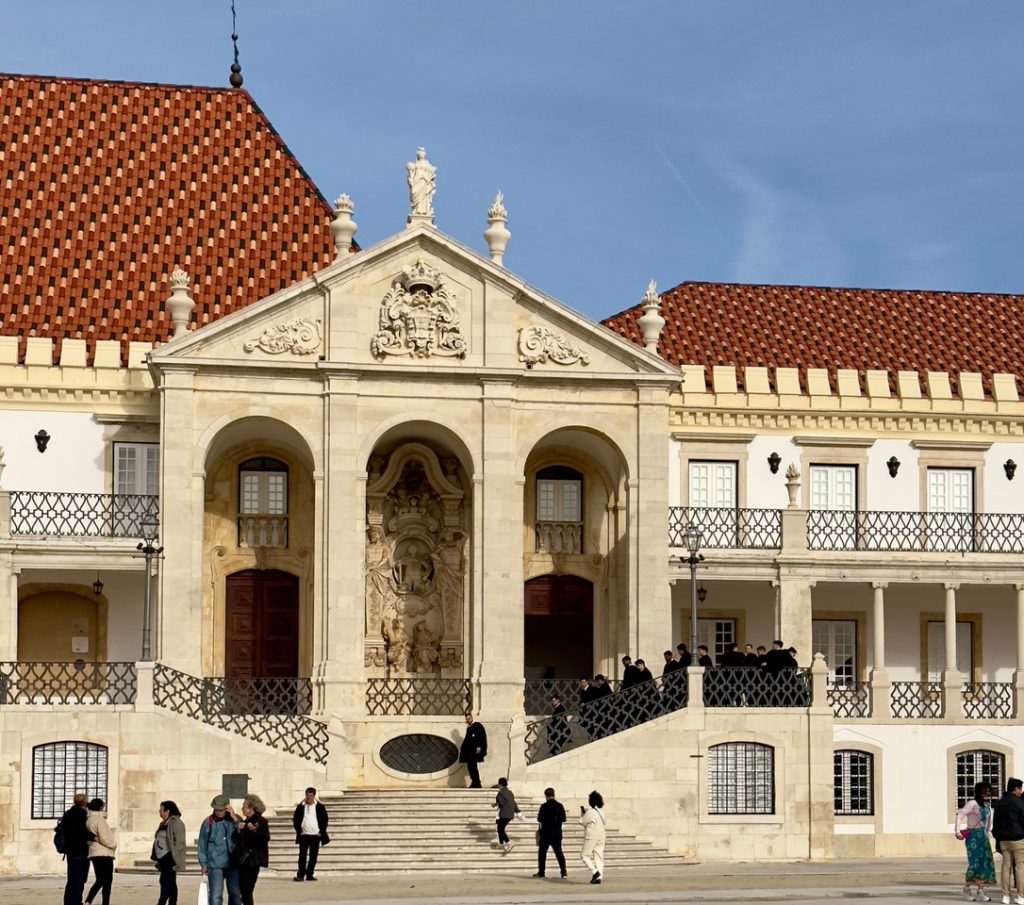
Cabinet of Curiosities
Walk across campus to reach the engrossing Cabinet of Curiosities. If science fascinates you as it does me, you can’t miss this. To indulge in more science, continue to the Science Museum, Chemistry Laboratory, and Physics Cabinet. Purchase tickets online to enter all these sites and book a time for the library.
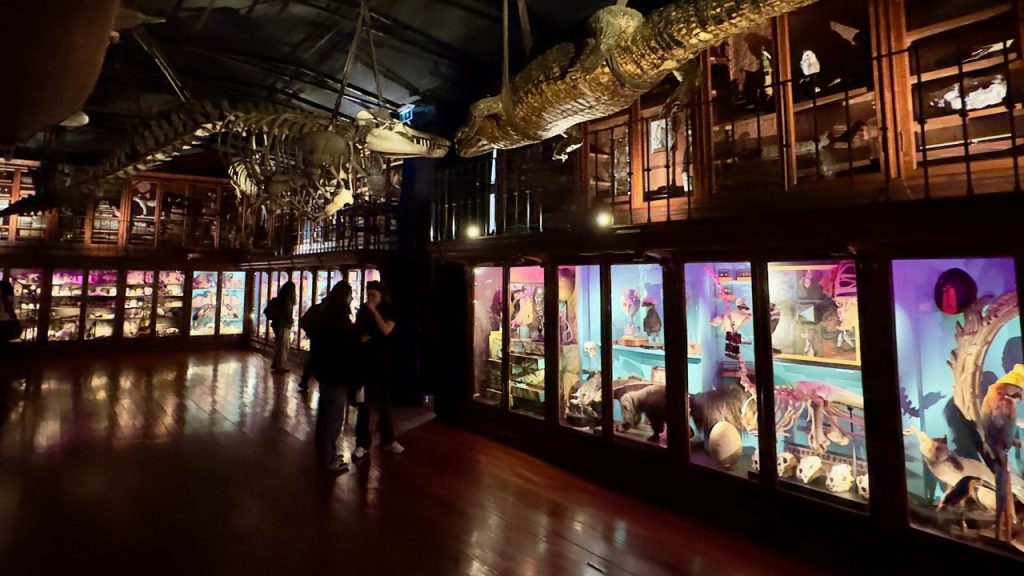
Botanical Garden
The university established a botanical garden adjacent to the campus in 1772, providing a tranquil setting to enjoy nature. The park includes a large greenhouse built in the 19th century, a bamboo stand, a shaded greenhouse filled with ferns, and a formal English garden.
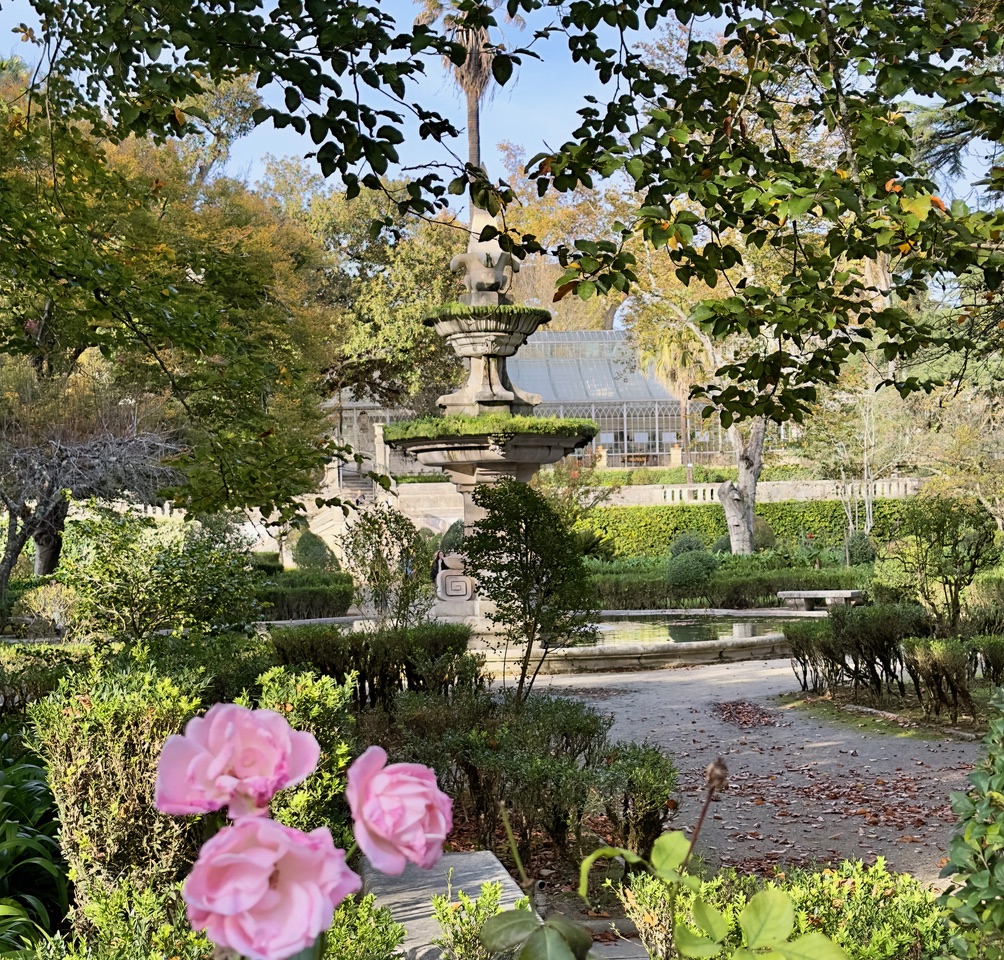
Machado de Castro National Museum
In the lower level of the Machado de Castro National Museum, you can walk through passageways of the cryptoporticus and the foundations of a forum of the ancient Roman city of Aeminium. The museum galleries contain Roman artifacts and religious art from the 12th to 18th centuries. The café offers a good buffet lunch with a view over Coimbra.
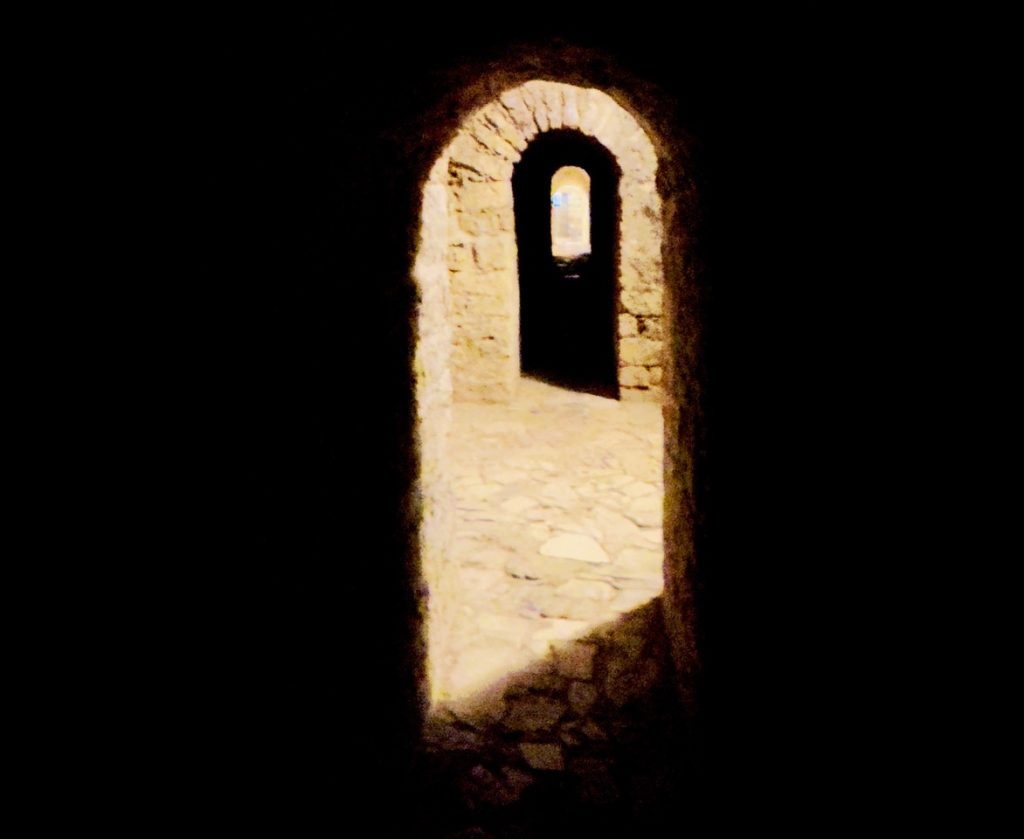
Santa Cruz Church and Monastery
The small scale of the Santa Cruz nave disguises the importance and scope of the complex. Due to the tombs of the first two Portuguese kings, it serves as a national pantheon. The church, primarily built in the 1500s, features Manueline architecture with the addition of elaborate Baroque tiles on the walls, an ornate red and gold organ with 4,000 pipes, and a choir loft with stalls adorned with golden carvings.
You walk through an impressive sacristy and chapter room to reach the monastery, which was begun in the 12th century. The ground floor of the peaceful cloister is laced with pale yellow, blue, and purple tiled scenes. The second floor leads to an oval-shaped sanctuary with relics.
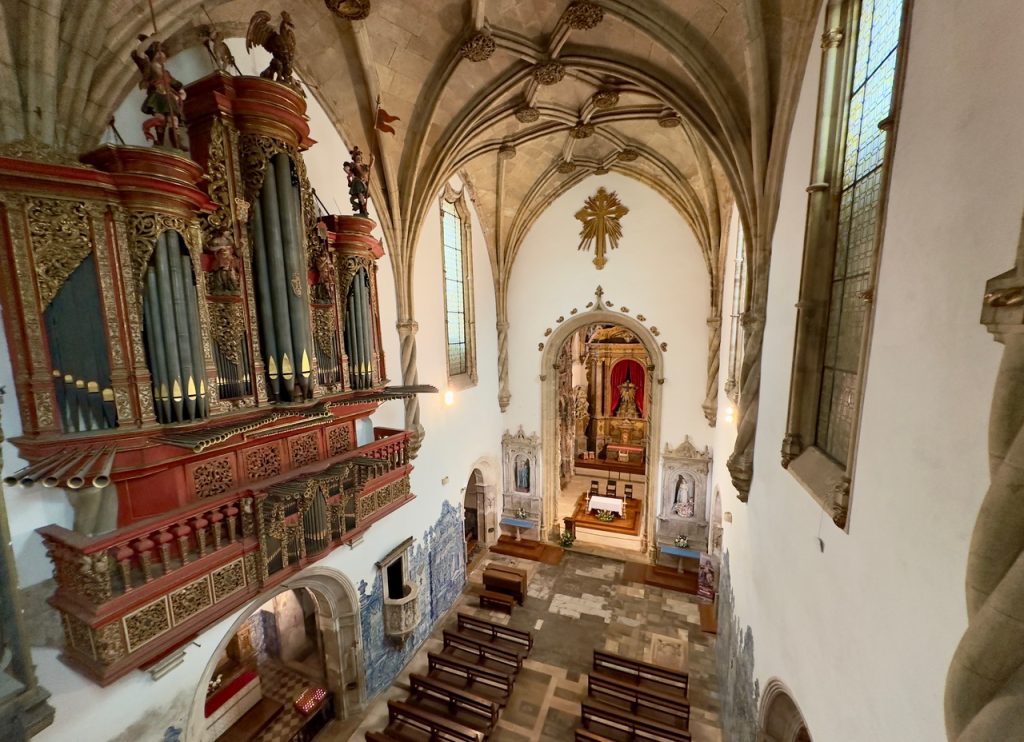
Se Velho de Coimbra
On your way up the hill to the university, stop at the Old Cathedral of Saint Mary. The interior is dark and foreboding, but it contains intricate altars and beautiful tile and stained-glass windows worth viewing. Another cloister awaits, perfect for quiet reflection. When I visited in November, I had the courtyard to myself, and I lingered there for a while.
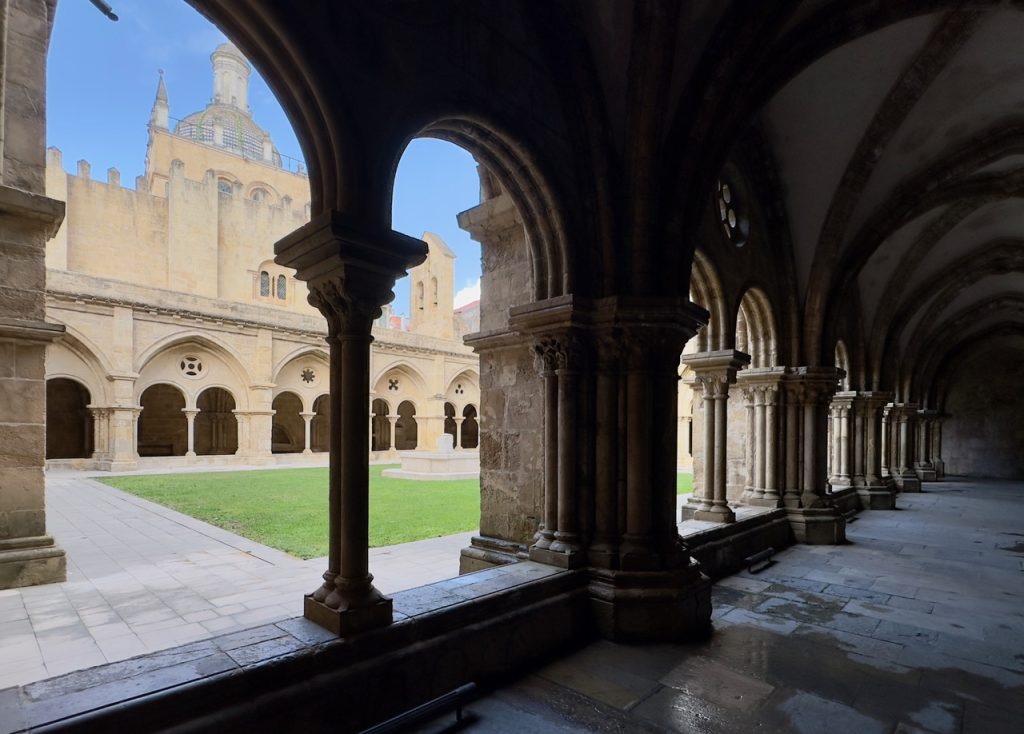
Fado Ao Centro
Three former students at the University of Coimbra founded Fado Ao Centro in 2010 to educate and entertain. The performers, all male, don their traditional black cloaks as they describe the history and cultural importance of fado music. Purchase tickets online for their nightly show.
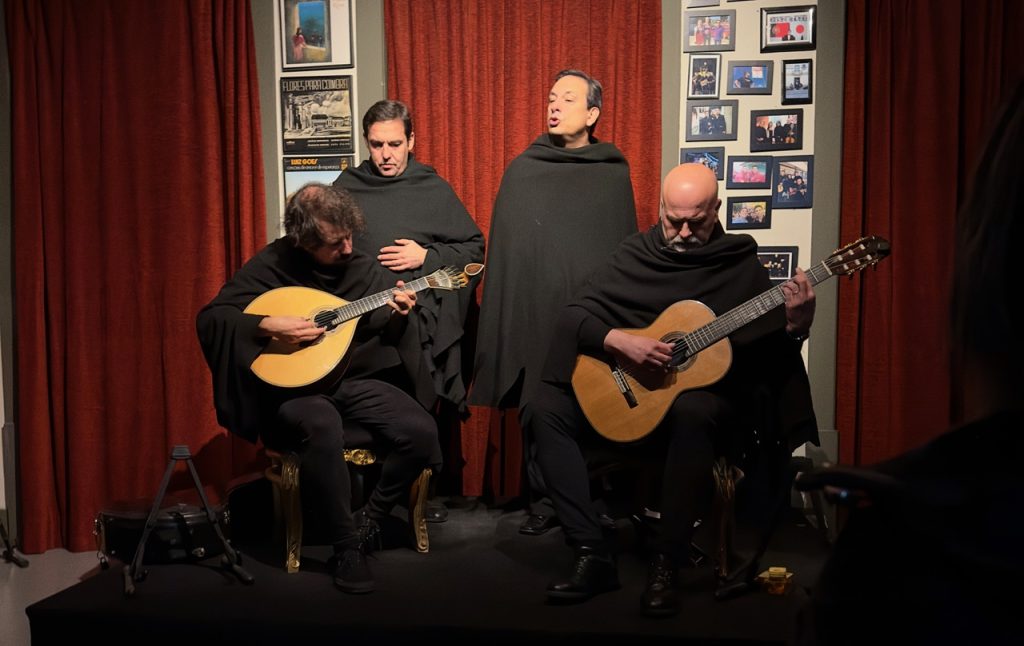
How To Get There
A regional train leaves from Santa Apolonia in southeast Lisbon and arrives at Coimbra-B Station in two hours. This station is approximately two kilometers from the town center. You can then take another train to Coimbra-A, near the center, or call for a ride outside the station using the Bolt ride-share app.
When staying in Coimbra, you won’t need a car, as the town is compact and all the sights are easily walkable. If you do drive, however, you can visit the impressive Roman ruins of Conimbriga, about 25 minutes outside town. You can also book a tour through Viator or Get Your Guide.
Évora – Roman History Revealed
A Roman temple in the center of town primarily drew me to Évora, and I discovered intriguing historical sights, awe-inspiring churches, and a relaxed atmosphere perfect for strolling, dining, and shopping.
Roman Temple
Emperor Julius Caesar named the town at the center of an important wheat-growing area after his beloved daughter. The citizens of Ebora Liberalitas Julia then erected a forum to celebrate his successor, Augustus, incorporating a temple that survived over the centuries. In the 17th century, a story incorrectly labeled the structure as the Diana Temple, and that name sticks to this day.
I loved that I could visit this UNESCO World Heritage Roman ruin multiple times during my three-day trip. It sits in the middle of a plaza without even being roped off. A small park adjoins it where you can sit and gaze at the temple or take in the view over the countryside.
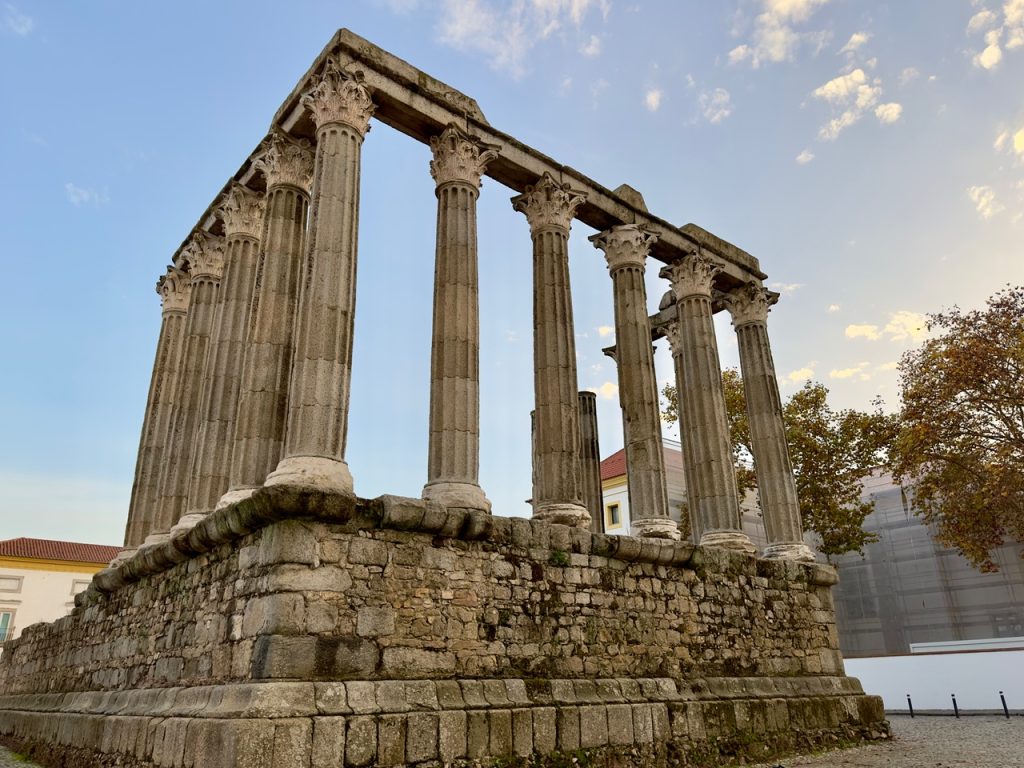
Évora Se
The Évora Se, or Cathedral, built from the late 12th to the middle of the 13th century, showcases the Roman-Gothic style of architecture. The geometric stone pattern soars up the columns and across the arched ceiling. Ornamental elements delight the eyes throughout, from exquisite gilded-wood chapels to elaborate golden gates and grandiose chandeliers.
The rooftop terrace continues the ornate look with its turrets and edges, offering a stunning view of the town and surrounding countryside. The cloister continues this artistry in a simplified form, with circular windows above curved arches that encircle a lush lawn.
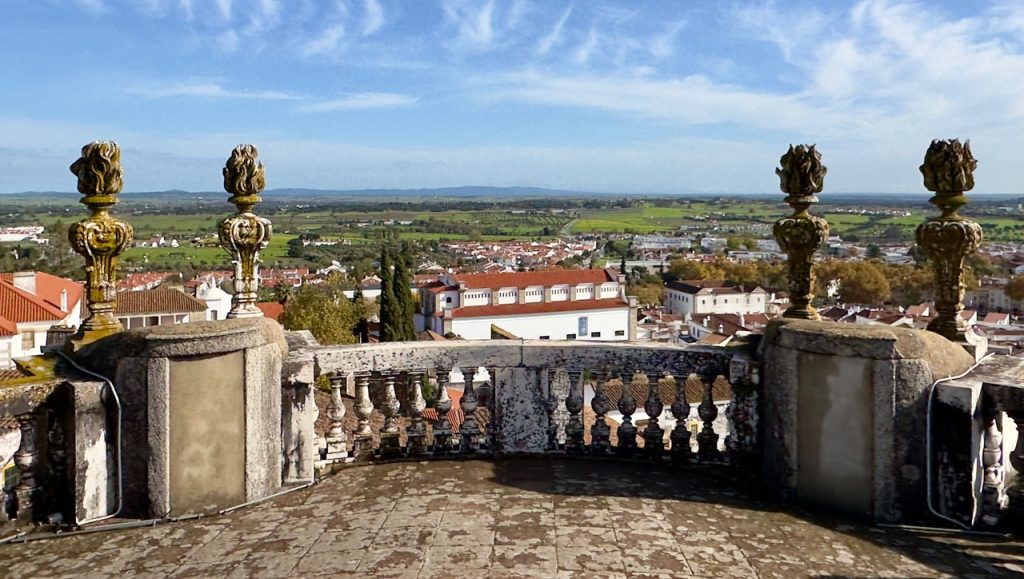
Friar Manuel do Cenaculo National Museum
A major portion of the collection of the Museum of Evora consists of the findings of archeological digs by Friar Manual do Cenaculo, the Bishop of in the late 18th century. He unearthed weapons, jewelry, household items, tombstones, and statues from the Roman era, demonstrating the extent of the Roman occupation of Portugal.
The collection also contains Portuguese paintings from the 15th and 16th centuries. It includes 13 pictures commissioned by Évora’s Bishop in 1495 to hang behind the altar of the cathedral. The museum, during excavations in their cellars, unearthed a necropolis dating from the 11th or 12th centuries. The skeletons appeared to be of Islamic and Christian origin, based on the burial style and items discovered alongside them.
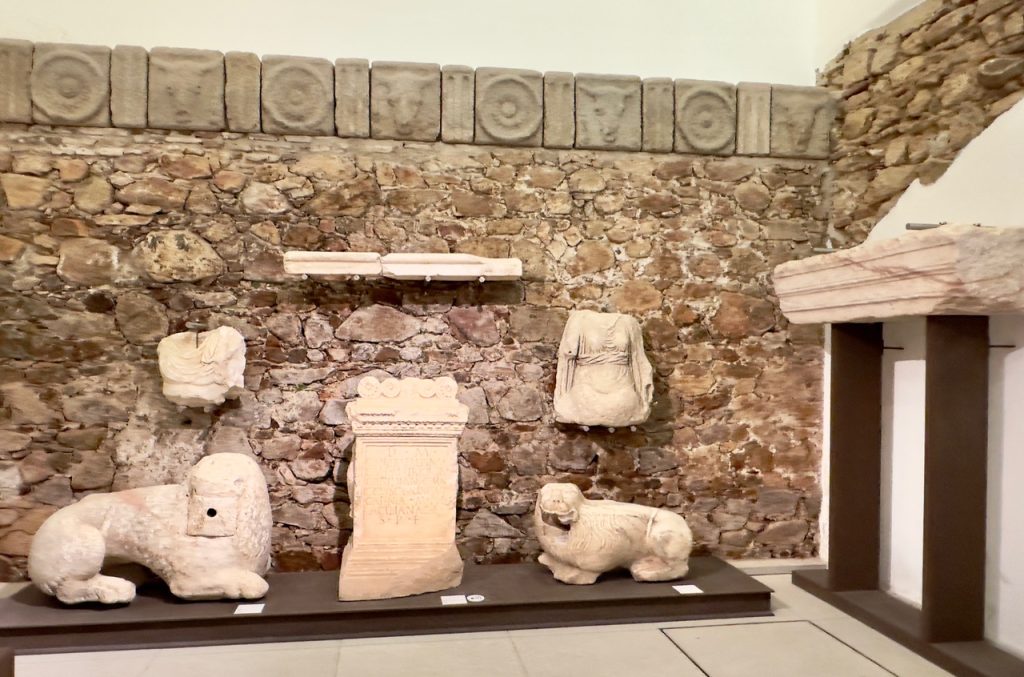
Cadaval Palace
The Cadaval Palace stretching across the plaza adjacent to the Roman Temple has a simple, yet elegant style. After you enter the courtyard, stone steps on the right lead up to an art gallery. The space includes furniture and other objects from the personal collection of the Dukes of Cadaval Family, the owners of the home since the 14th century.
The showpiece of the estate is the church of St. John, the Evangelist. Glazed tiles designed in 1711 with scenes depicting the life of St. Lawrence fill every space on the walls of the small interior.
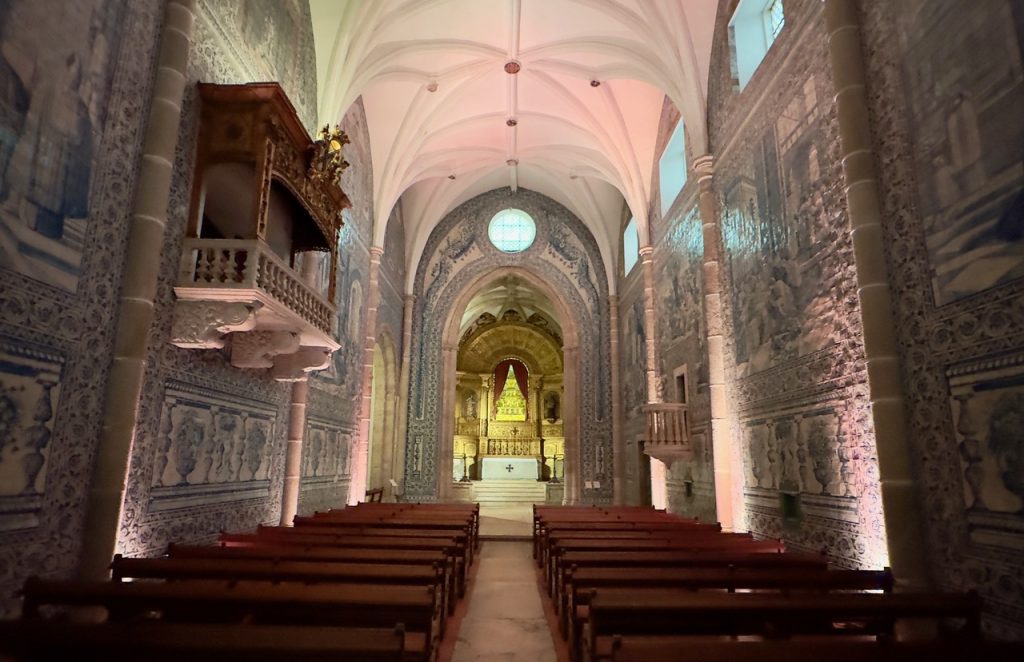
São Francisco
The simple exterior of São Francisco Church disguises the ornate details inside with patterned brick work, heavily gilded altars, and complex tile designs. The chilling yet fascinating Chapel of Bones invites visitors to contemplate the time when they will join their predecessors there. The museum features an engaging collection of nativity scenes from diverse times and places around the world, as well as paintings and artifacts from the Third Order of Saint Francis.
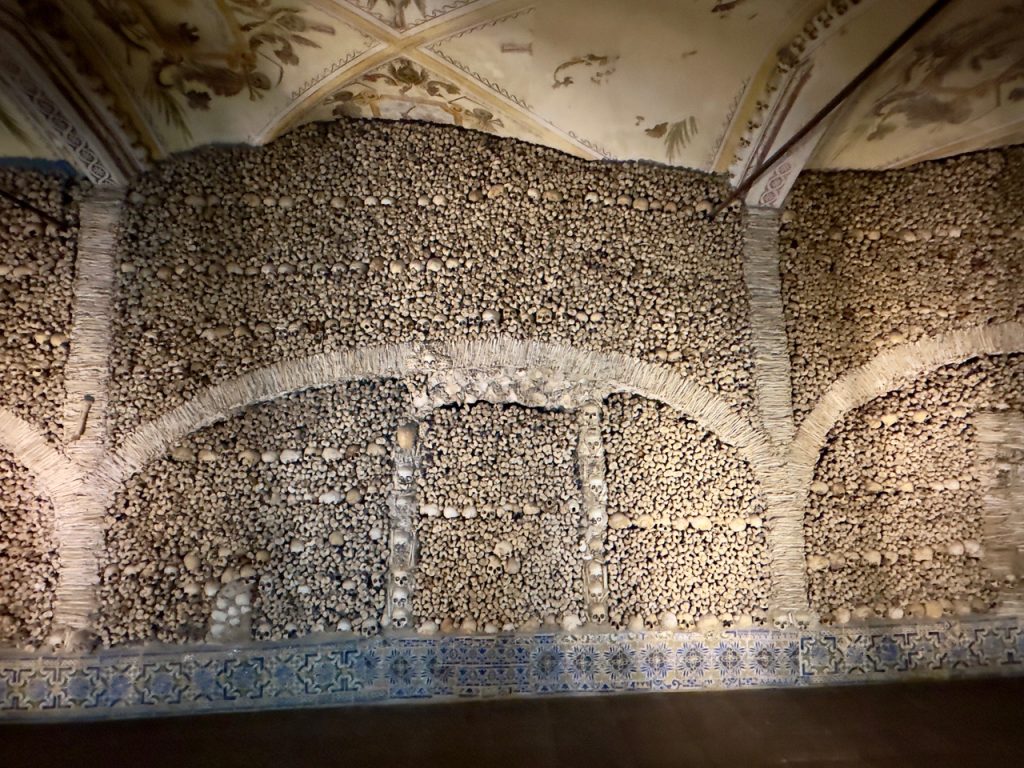
Jardim Publico
The Public Garden next to Sao Francisco offers large trees, red benches, and a bunch of peacocks. You can pass through the fake ruins to wander along a segment of the Medieval Walls.
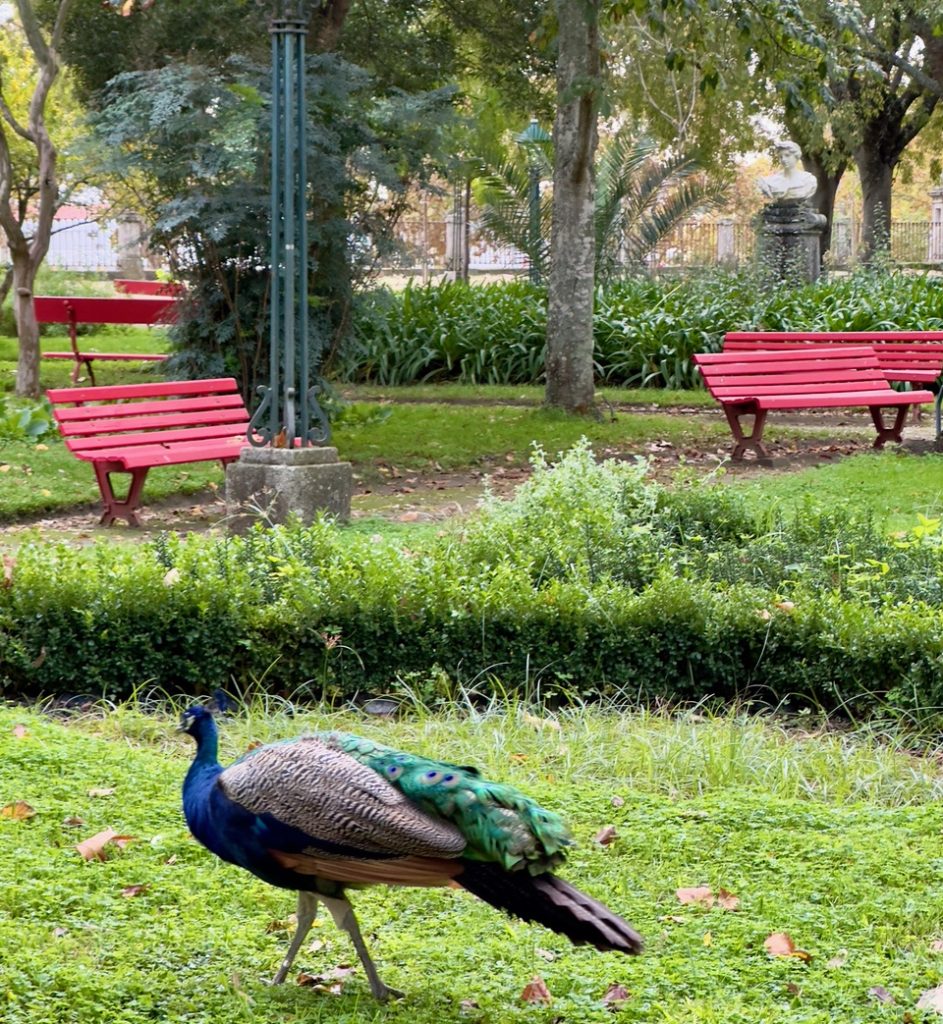
How to Get There
Several bus and train routes connect Lisbon to Évora. I rode the train from Santa Apolonia Station directly to Évora Station, which took 90 minutes. I walked 15 minutes into the center of town, but the rough, cobbled-stone streets did not make it easy. Driving to Évora would take approximately one and a half hours.
Conclusion
The best towns to explore on your trip to Lisbon contain Roman ruins, ornate churches, elaborate palaces, and peaceful natural sights. By using Lisbon as a hub, visitors can enjoy the best of Portugal with travel of less than two hours to discover a wealth of experience.
For help exploring Lisbon, check out my Ultimate Guide for Solo Travel in Lisbon, which has great tips for every traveler.
